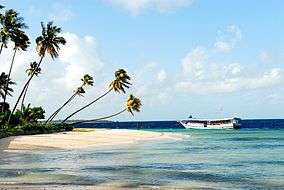Wakatobi National Park
| Wakatobi National Park | |
|---|---|
|
IUCN category II (national park) | |
 | |
 Wakatobi NP | |
| Location | Southeast Sulawesi, Indonesia |
| Nearest city | Bau-Bau |
| Coordinates | 5°41′S 124°0′E / 5.683°S 124.000°ECoordinates: 5°41′S 124°0′E / 5.683°S 124.000°E |
| Area | 13,900 km2 |
| Established | 2002 |
| Governing body | Ministry of Forestry |
Wakatobi National Park is a marine national park in Southeast Sulawesi, Indonesia. The name of Wakatobi is an acronym of the four main Tukangbesi Islands: Wangi-wangi, Kaledupa, Tomia, and Binongko.[1] Since 2005 the park is listed as a tentative World Heritage Site.[2]
Location and topography
Wakatobi National Park is located south-east of Sulawesi, between 05°12’-06°10’S and 123°20’-124°39’E, between the Banda Sea to the north-east and the Flores Sea to the south-west.[1]
It consists of four larger islands: Wangi-Wangi, Kaledupa, Tomia and Binongko, as well as many small islands such as Tokobao, North Lintea, South Lintea, Kampenaune, Hoga and Tolandono. The highest elevation is 274 metres (899 ft) on Wangi-Wangi, followed by Lagole Hill (271m) on Tomia, Terpadu Hill (222 m) on Binongko and Mount Sampuagiwolo (203 m) on Kadelupa.[1] The water depth varies, with the deepest parts reaching 1,044 metres (3,425 ft).[2]
The Wakatobi National Park — the third largest marine park in Indonesia. Legendary underwater explorer and conservationist, Jacques Cousteau is said to have called the Wakatobi islands – then known as the Tukangbesi islands: an “Underwater Nirwana”. Now a national marine park covering the entire Waktobi District, it comprises 1.4 million hectares, of which 900,000 hectares are decorated with different, colourful species of tropical coral reefs. For Wakatobi is widely recognized as having the highest number of reef and fish species in the world. The islands are also famous as the largest barrier reef in Indonesia, second only to the Great Barrier Reef in Australia. This is the habitat of large and small fish species, the playground of dolphins, turtles and even whales. Wonderful Indonesia: Wakatobi National Marine Park The island group comprises 143 larger and smaller islands where only 7 are inhabited counting a total population of around 100,000, while the others remain uninhabited. Most notable are the Bajo communities, the seafaring nomads who inhabit many of Indonesia’s remote islands.
Flora and fauna

Located right in the heart of the Asia-Pacific Coral Triangle, in the province of South East Sulawesi, the Wakatobi Islands offer crystal clear pristine waters and a rich bio-diverse underwater life, a true paradise for divers, as this is one of 3 hearts in the World Coral Triangle that stretches from the Solomon Islands in the Pacific to Wakatobi, and North to the Philippines. Wakatobi alone is said to have 942 fish species and 750 coral reef species from a total of 850 of world's collection, which, comparing with the two world's famous diving centers, the Caribbean Sea owns only 50 species with 300 coral reef species in the Red Sea, in Egypt.Wonderful Indonesia: Wakatobi Marine National Park
The types of vegetation found in the national park are mangrove forest, coastal forest, lowland swamp forest, riverbank vegetation, lowland rainforest, mountain rainforest and coral reefs. The Wakatobi Archipelago has 25 groups of coral reefs including fringing reefs, barrier reefs and atolls.[1] A survey conducted in 2003 identified 396 species of coral belonging to 68 genera and 15 families.[3] These include Acropora formosa, Acropora hyacinthus, Psammocora profundasafla, Pavona cactus, Leptoseris yabei, Fungia molucensis, Lobophyllia robusta, Merulina ampliata, Platygyra versifora, Euphyllia glabrescens, Tubastraea frondes, Stylophora pistillata, Sarcophyton throchelliophorum, and Sinularia species.[4]
Among the recorded species of seabirds are the brown booby, common kingfisher and Malaysian plover.[4]
Turtles in the park include the hawksbill turtle, loggerhead sea turtle, and olive ridley.[4]
Human habitation
The main settlement in the islands is the administrative centre for the Regency Bau-Bau. In 2001 there were nearly 90,000 people living in the islands.[3]
The indigenous people who live around the Park belong to the Bajau ethnic group. Locals still commonly use spear-fishing.[4]
Conservation and threats
After the designation of the Wakatobi Marine Conservation Area in 1996, the Wakatobi National Park with a total area of 1,390,000 ha has been established in 2002. It is managed by the Wakatobi National Park Authority (Balai Taman Nasional).[1] In 2005 the park has been listed as a tentative World Heritage Site.[2] In 2012 it was included in the World Network of Biosphere Reserves.[5]
Major threats are posed by overfishing and destructive fishing practices,[6] including fish bombing and poison fishing.[3]
References
- 1 2 3 4 5 Lestari Hutan Indonesia, retrieved 23 July 2010
- 1 2 3 "World Heritage Tentative List: Wakatobi National Park". UNESCO. Retrieved 23 July 2010.
- 1 2 3 WWF: Rapid Ecological Assessment Wakatobi National Park, 2003, retrieved 23 July 2010
- 1 2 3 4 Ministry of Forestry: Wakatobi National Park, retrieved 23 July 2010
- ↑ UNESCO: "Ecological Sciences for Sustainable Development", retrieved 22 October 2013
- ↑ The Nature Conservancy: Wakatobi National Park, retrieved 23 July 2010
External links
![]() Media related to Wakatobi National Park at Wikimedia Commons
Media related to Wakatobi National Park at Wikimedia Commons
| ||||||||||||||||||||||||||